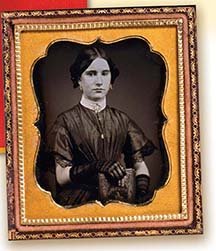SECTION 4: The Women’s Movement

▲ Woman who worked in the temperance reform movement, 1851
WITNESS HISTORY  AUDIO
AUDIO
Equality for Women
The sisters Sarah Grimké and Angelina Grimké Weld were ardent abolitionists. Through their work on the behalf of slaves, they became interested in fighting for the rights of another oppressed group: women.
“I am persuaded that the rights of woman, like the rights of slaves, need only be examined to be understood and asserted, even by some of those, who are now endeavouring to smother the irrepressible desire for mental and spiritual freedom which glows in the breast of many….
Men and women were CREATED EQUAL; they are both moral and accountable beings, and whatever is right for man to do is right for woman.”
—Sarah Grimké, Letters on the Equality of the Sexes and the Condition of Women, 1838
Objectives
- Identify the limits faced by American women in the early 1800s.
- Trace the development of the women’s movement.
- Describe the Seneca Falls Convention and its effects.
Terms and People
- matrilineal
- Sojourner Truth
- women’s movement
- Lucretia Mott
- Elizabeth Cady Stanton
- Seneca Falls Convention
- Amelia Bloomer
- suffrage
- Married Women’s PropertyAct
NoteTaking
Reading Skill: Identify Causes and Effects Use a chart to record the causes and effects of the women’s rights movement in the 1800s.

- Limited rights
Causes
→
- Birth of women’s rights movement
Events
→
Effects
Why It Matters A spirit of reform permeated American life in the early and middle 1800s. Women took active roles in the abolition movement and other reform movements. Soon, some of these reformers began to work to gain equality for women as well. Their efforts would lay the groundwork for women’s struggle for equal rights over the next hundred years. Section Focus Question: What steps did American women take to advance their rights in the mid-1800s?
Women Work for Change
In the 1800s, American women’s freedoms and rights were sharply limited. Instead of taking a powerful role in public life, women were expected to make a difference privately, by influencing their husbands and raising their children to be good Americans. But this idealized influence was too limiting for women. Largely as a result of the Second Great Awakening, women of the early 1800s began to take on more active roles in public life.
Women Face Limits
In the early 1800s, American women lacked many basic legal and economic rights. Under the British legal traditions that dominated the United States, women usually could not hold property or hold office or vote, and they usually were forbidden even to speak in public. Formal educational opportunities were virtually unheard of. In the rare instances of divorce, husbands generally gained custody of children.




